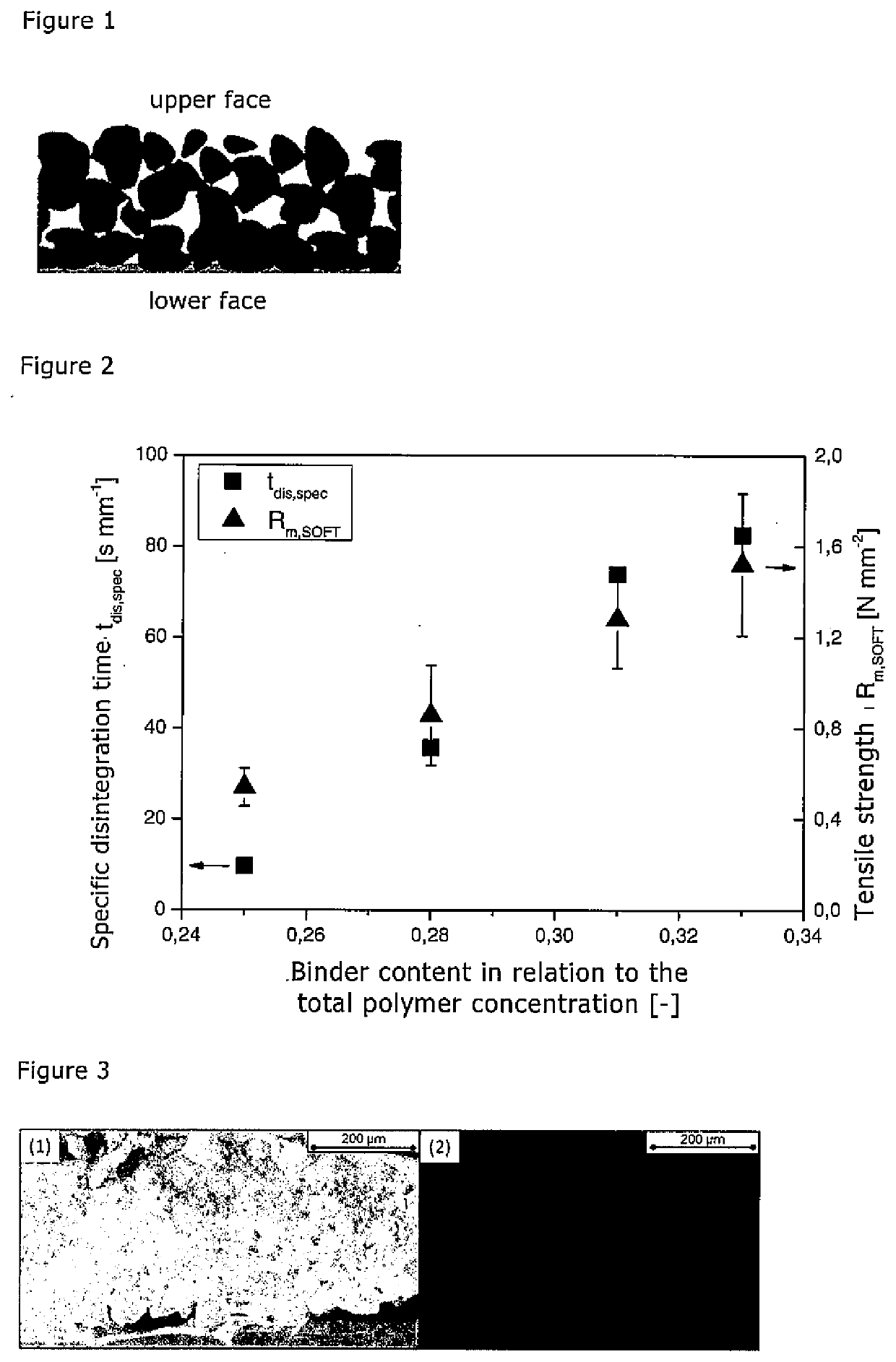Structured orodispersible films
a technology of orodispersible films and orodispersible films, which is applied in the direction of pharmaceutical non-active ingredients, pharmaceutical delivery mechanisms, bands, etc., can solve the problems of adverse effects on the progression of healing or the success of therapy, poor compliance, and known orodispersible films
- Summary
- Abstract
- Description
- Claims
- Application Information
AI Technical Summary
Benefits of technology
Problems solved by technology
Method used
Image
Examples
example 1
[0056]The following tests were performed on the basis of suspensions having different matrix / binder ratios. The suspensions used for this purpose contained ethanol as solvent, HMPC (Pharmacoat 606) as matrix material and HPC (Sigma Aldrich) as binder. The suspension was produced by dissolving HPC in ethanol and subsequently adding the matrix material. The suspension thus obtained was degassed for 16 hours and was then applied to a PET film using an automatic ZAA 2300 film applicator (Zehntner, Switzerland). The application rate was 10 mm s−1 and the distance from the substrate was 1000 μm. The films were dried at 50° C. for 30 min in a furnace and were then detached from the substrate.
[0057]In the suspensions used for production of the films the ethanol content was cEtOH=0.735. The proportion of the binder, in relation to the total quantity of matrix material and binder (cHPC), was varied in the range of from 0.25 to 0.33. For each of the films thus obtained the film thickness, the ...
example 2
f Orodispersible Films with a Model Active Ingredient
[0067]In order to be able to determine the distribution of a model active ingredient in the orodispersible films according to the invention, the loading of the films was examined with regard to a clear detection with an aluminium oxide suspension (x50=100 nm, solvent=ethanol). The distribution of the aluminium oxide in the film was then determined by SEM / EDX (element tracking) (see FIG. 3). These tests were able to show that the incorporation of the particles in the film pores was possible and that the suspensions penetrated the orodispersible film as far as the closed lower face. It was also possible to show that the porous matrix film did not dissolve during the loading.
example 3
of the Coating Cycles and Particle Concentration
[0068]For these tests an anthraquinone suspension (x50=400 nm) was used. These contained, in addition to the anthraquinone, also HPC as stabiliser in a concentration of cHPC=0.25 (in relation to the total quantity of anthraquinone in the suspension). The concentration of the suspension was varied in a range of from 0.05 to 0.2, and the suspension was applied between one and five times to the film. The suspension was applied to the film surface via an application nozzle with a volume of 25 μm / min at a rate of 220 mm / min. The film used for the tests was a film with cHPC=0.28, as described in Example 1.
[0069]The loading with anthraquinone was determined for each of the obtained films. The results of these tests are shown in FIG. 4.
[0070]The tests showed that the highest loading of 6.1 mg / cm2 with an anthraquinone concentration of 0.2 could be realised in five coating cycles. This corresponds to an anthraquinone loading of 4.9 mg / cm2. Unde...
PUM
| Property | Measurement | Unit |
|---|---|---|
| mean particle size | aaaaa | aaaaa |
| mean particle size | aaaaa | aaaaa |
| mean particle size | aaaaa | aaaaa |
Abstract
Description
Claims
Application Information
 Login to View More
Login to View More - R&D
- Intellectual Property
- Life Sciences
- Materials
- Tech Scout
- Unparalleled Data Quality
- Higher Quality Content
- 60% Fewer Hallucinations
Browse by: Latest US Patents, China's latest patents, Technical Efficacy Thesaurus, Application Domain, Technology Topic, Popular Technical Reports.
© 2025 PatSnap. All rights reserved.Legal|Privacy policy|Modern Slavery Act Transparency Statement|Sitemap|About US| Contact US: help@patsnap.com


